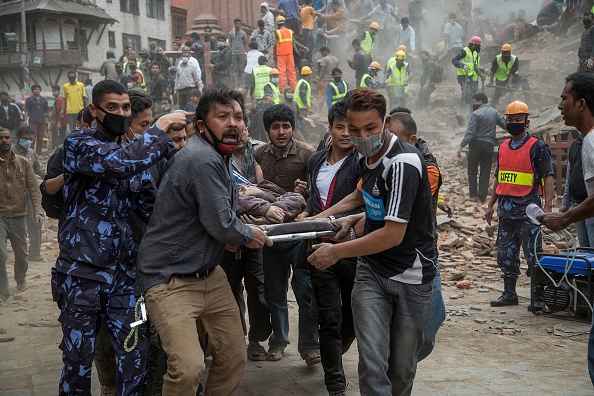Devastation After Nepal Quake
Please consult our tips and resources on covering disaster, interviewing victims and survivors, and working with reporters exposed to traumatic events.

A powerful earthquake shook Nepal on Saturday morning near its capital, Kathmandu, killing more than 8,000 people, leveling sections of the capital’s historic center and trapping hundreds in a 200-foot watchtower that came crashing down. Nepali authorities say the current death toll could continue to rise, as many are believed to be trapped under the rubble.
The 7.8 magnitude quake also set off landslides on the slopes of Mount Everest, where several hikers were reported to have died and many more remain stranded. The quake was felt far and wide — at least 50 people died in neighboring India, Bangladesh, Pakistan, Tibet and China.
All across the country, walls tumbled, trees split, power lines snapped and large cracks opened up in the streets. Tens of thousands prepared to spend the night in open spaces outside to avoid the collapsing buildings and falling debris.
By Saturday evening the United States Geological Survey had counted more than two dozen aftershocks, one of which measured at a magnitude of 6.6.
The Dart Center has a host of tips and resources for journalists covering tragedy on this scale below:
- The Dart Center's quick tips, in-depth resources and links to other organizations on "Covering Disasters."
- "Tragedies and Journalists": the Dart Center's comprehensive guide for reporters, editors, photographers and managers on every aspect of reporting tragedy.
- An interview with Irving Redlener, M.D. on the role that news media play in aiding recovery and drawing lessons to better manage future catastrophes.
- Guidance on mental health issues and how they evolve in regions devastated by natural disasters, from psychiatrist Alexander McFarlane.
- Guidance on working with emergency services from Dr. Anne Eyre, specialist in trauma and disaster management.
- A list of relief agencies in Nepal, compiled by the New York Times
- Guidance on reporting natural disasters from Manoucheka Celeste, Haitian-born journalist and media scholar.
- "Best Practices in Trauma Reporting," drawn from a decade of Dart Award-winning stories.
- Tip Sheets on how to effectively cover a disaster and self-care amid disaster from 2014 Pulitzer Prize winning editor Joe Hight.
- Scientific consensus, made readable, on the effects of traumatic coverage on journalists and on media consumers.
- Dart Centre Asia Pacific's self care tips for news personnel exposed to traumatic events, staff care tips for their managers and editors and reporting tips for dealing with victims of tragedy.
- Reflection and advice from six international reporters who were on the ground during the 2004 Indian Ocean tsunami -- Yulia Supadmo, Indonesia; Mehul Srivastava, USA; Shahanaaz Habib, Malaysia; Shahidul Alam, Bangladesh; Pia Sarkar, USA; Mona Khanna, USA -- as well as Australian photojournalist Patrick Hamilton and correspondent Kimina Lyall.
- Transcript and individual reports from a Frontline Club discussion of tsunami coverage, with former Dart Centre Europe Director Mark Brayne, BBC developing world correspondent David Loyn and clinical psychologist Bill Yule.
- The International Center for Journalists's two-part guide on Disaster and Crisis Coverage and Journalism and Trauma.
- Natural Disaster resources assembled by Google, including Google's person-finder.
- Recovery from Unnatural Death: A guide by psychiatrist Ted Rynearson for friends and family of someone who has died violently or suddenly.
- Dart Center Executive Director Bruce Shapiro spoke in Melbourne, Australia about reckoning with the aftermath of disaster.
- How to deal with people caught up in tragic events.
- Tips for managers and editors to help them prepare and support reporters in the field.
- Facebook now has a page for photos of the missing.
































































































